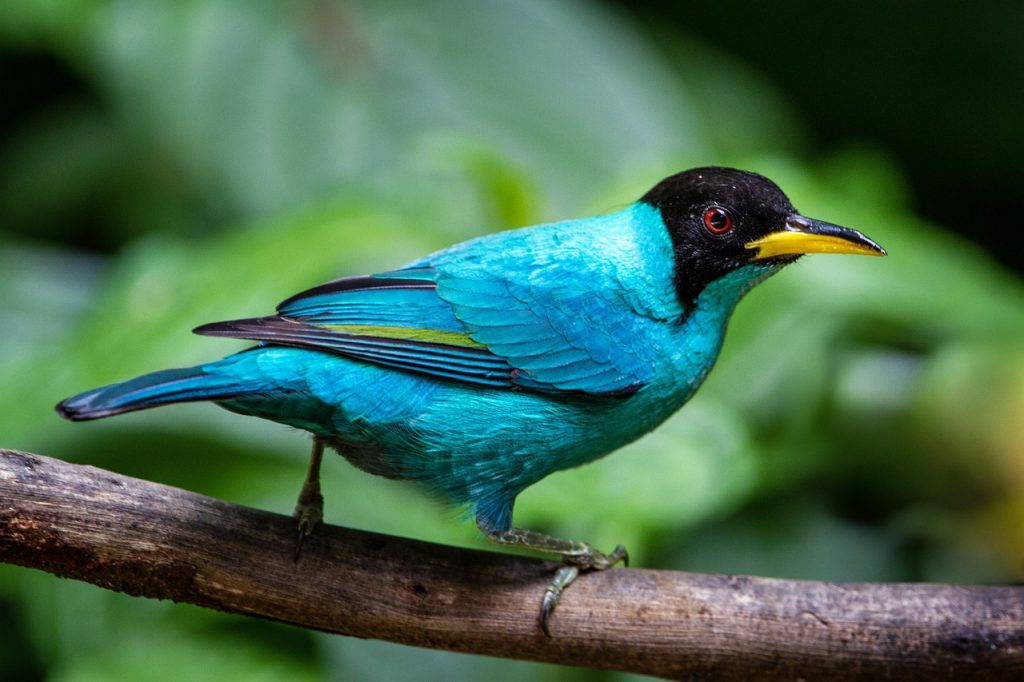
The rainforests of Africa are a treasure trove of biodiversity, boasting an incredible array of flora and fauna. Among the myriad species that call these lush habitats home, birds stand out as the most vibrant and diverse inhabitants of the rainforests.
In this article, we will explore some of the fascinating rainforest birds that grace the canopies and forest floors of Africa, weaving their splendour into the rich tapestry of its ecosystems.
African Grey Parrot
One of the most iconic and intelligent parrot species, the African Grey Parrot, is native to the dense rainforests of West and Central Africa. Renowned for their remarkable mimicking abilities and cognitive prowess, these birds are often kept as pets.
However, their populations face threats due to habitat loss and the illegal pet trade. African greys are frugivores, feeding mainly on fruits, nuts, and seeds. Little is known about their behaviour in the wild, but they are monogamous, and pairs typically mate for life.
Great Blue Turaco
A strikingly beautiful bird, the Great Blue Turaco is a spectacular sight in the rainforest canopy. Its deep, teal-coloured plumage stands out amid the forest foliage. It has a fan-shaped, blue-black crest and an orange-tipped yellow bill. Great blues are social birds found in small flocks.
Found in the central and western regions of Africa, these large frugivores subsist on a diet of fruits, flowers, and leaves and play a crucial role in seed dispersal, contributing to the forest’s ecological balance.
African Crowned Eagle
Among Africa’s largest and most powerful raptors, the African Crowned Eagle commands attention with its impressive size and hunting prowess. Crowned eagles primarily hunt medium-sized mammals, such as hyraxes, monkeys, and small antelope.
They live in the rainforests and dense woodlands, with a population concentration in East Africa. African crowned eagles are bold raptors and fiercely territorial. They are known to attack humans that veer too close to their nesting sites. The species is in decline due to deforestation.
Congo Peafowl
Endemic to the Congo Basin rainforest, the Congo Peafowl is the only African peafowl species. This unusual groundbird is shy and elusive, inhabiting the lowland forests where its droppings and feathers tell of its whereabouts.
While it is less flamboyant than its Asiatic cousins, the males have deep-blue plumage with an iridescent sheen in shades of green and violet. The Congo peafowl is an omnivore. It feeds on fruits as well as insects and other invertebrates. Populations are in decline due to hunting and habitat loss.
African Pitta
Known for its vibrant plumage and explosive calls, the African Pitta is a small passerine bird found in the understory of Central and West African rainforests. Despite their bold coloration and loud call, African pittas are rarely observed due to their elusive behaviour.
They inhabit riparian and coastal forest thickets, where they flit about, foraging leaf litter for insects and invertebrates, adding a splash of color to the forest floor.
Picarthartes Rockfowls
There are only two species of rockfowl, and both inhabit the dense rainforests of tropical West and Central Africa. These peculiar birds capture the imagination of bird enthusiasts and researchers alike.
Also known as bald crows, they are slender birds with large beady eyes, featherless heads, and brightly coloured facial skin. While the species are named for their neck coloration—either white or grey—they are markedly different in appearance. These rainforest rockfowl are ground-dwelling birds that feed on insects and other invertebrates in their damp, rocky habitats. Both species are threatened by the destruction of forest habitats.
Copper-tailed Starling
The copper-tailed starling gets its name from the dazzling copper-colored feathers adorning its square-shaped tail that intensify during the breeding season, creating a sharp contrast against its dark, glossy plumage with iridescent sheen in shades of purple and blue.
This stunning species inhabits moist, lowland forests in West Africa, where it forages the canopy for insects and fruit. The species is classified as “near-threatened” on the IUCN Redlist.
African Green Broadbill
Also known as Grauer’s Broadbill, this little green marvel of the rainforest bears a striking plumage that seamlessly blends with the verdant foliage of its forest habitat. It has a black and streaked yellow crown, a black eye mask, and a powder-blue throat.
Unlike other broadbill species, it has a small bill. This insular species is endemic to the montane forests of the Albertine Rift, where it can be spotted flitting about, foraging for seeds, fruit, buds, and flowers. This species faces the ongoing threat of habitat loss due to deforestation and human encroachment.
Prigorgine’s Sunbird
This mysterious species is endemic to the riparian forests of the Marungu Highlands. Sunbirds are tiny birds—comparative to hummingbirds—that occupy a similar niche in African ecosystems.
The Marungu sunbird is a relatively large species, with colourful males cloaked in green and red. The females, by contrast, have drab brown plumage. Prigorine’s sunbirds are found in montane forests and forest edges. They migrate short distances as the seasons change. Deforestation threatens their highly localised habitat.
White-crested Tiger Heron
Also known as the White-crested Bittern, this enigmatic species inhabits dense, lowland forests, wetlands, and mangroves in West Africa. It is a stout bird with dusky, barred plumage and a distinctive white crest for which it is named.
Typical of herons, the white-crested tiger heron subsists on a largely piscivorous diet of fish, crabs, frogs, crayfish, snakes, and insects. Its loud booming call can be heard echoing through the rainforest.
Vermiculated Fishing Owl
This large, wary species inhabits riverine forests. It is endemic to West-Central Africa. Name for its heavily patterned plumage, the vermiculated fishing owl has a tuftless, round head, yellow bill, and large brown eyes.
It hunts nocturnally and spends its days in well-hidden roosting sites. Lucky birders may hear its deep hooting call or spot its tawny plumage amid the foliage.
Congo Serpent Eagle
This dusky eagle specialises in hunting snakes and other reptiles and amphibians amid the dark understories of the African rainforests. It has dark upperparts, barred flanks, a white breast, and a long, banded tail.
This species is found in dense primary forests in West and Central Africa. Its dark eyes are adapted for hunting in low-light conditions. The Congo serpent eagle is a vocal bird. Its loud, mewing call may be confused with the call of a hornbill or turaco.
Cassin’s Hawk-Eagle
Another raptor of the rainforests, Cassin’s Hawk-Eagle is a small species of booted eagle. It lives in primary rainforests in West, Central, and East Africa, where it preys on tree squirrels and small birds.
This species is remarkably similar in appearance to the Congo serpent eagle—a similarity attributed to mimicry. The latter eagle, with its specialised reptilian diet, may benefit from this resemblance since its predators, prey, and rivals may confuse it with the bird-eating hawk-eagle.
Black-collared Lovebird
Also known as Swindern’s Lovebird, this small, skittish parrot inhabits lowland rainforests, forest edges, and clearings. Its diminutive size, green plumage, and elusive behaviour make it difficult to observe in the wild.
This lovebird species lives in the rainforest canopies, foraging for seeds and fruit, and builds its nests in cavities. Feral populations have been documented in various regions, but these populations cannot be sustained due to dietary restrictions. Little is known about its nesting behaviour in the wild.
Conclusion
Africa’s rainforests are alive with avian splendour, showcasing a diversity of species that captivates the imagination and underscores the importance of preserving these critical habitats. Each bird plays a unique role in the ecosystem, contributing to the delicate balance of life in the rainforest. By understanding and protecting these incredible species, we ensure that the vibrant chorus of Africa’s rainforests continues to resonate for generations to come.
